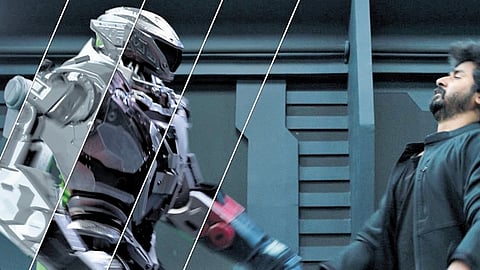

A signal from an extraterrestrial rock is flung across the vast universe. Tracing its trajectory, an alien descends upon Earth on its spaceship. The staircases unfold one by one and he jumps on the land when his censor issues a caution, “Beware of humans.” These captivating scenes, straight out of the establishing moments in Sivakarthikeyan’s 'Ayalaan', have been crafted by more than 1500 VFX artists, breathing life into the character and the film. VFX director Bejoy Arputharaj reveals that he feels a massive burden has been lifted off his chest. “This is a dream we have been carrying for several years. I feel elated to witness our collective efforts on the big screen,” he says.
Directed by Ravikumar, 'Ayalaan' has been receiving praise for its ‘realistic’ portrayal of the alien character. This was one of the key aspects that Bejoy, the CEO of PhantomFX Studios, zeroed in on before creating the visuals for it. “In order to connect with the audience, it needs to be realistic. Otherwise, it would feel as though we are watching an animated film. When we started out to design the character, we were intent on making it both photorealistic and cute,” he reveals.
What started out as a scribble, ‘Tattoo’ (the alien’s name), later evolved with the addition of several elements. “We added features like the bones on top of his head, tentacles, big eyes, and elf-like ears to make it look cuter.”
'Ayalaan' boasts of more than 4500 VFX shots, the most for an Indian film and Bejoy admits that there are several ‘invisible’ effects throughout the runtime. “Due to budget constraints, art director Muthuraj would set up a scene to a certain extent, and then we would expand it using VFX. We’ve crafted various elements, including buildings, the environment in Madagascar, helicopter shots, the villain’s office, lab rats, birds, and much more.” Sixteen departments in PhantomFX studios worked painstakingly for over a year to create the special effects for the film. “From sketching the initial drawing, adding intricate details, defining skin textures, designing its clothing, to rendering it in 3D, every step was undertaken by different VFX specialists. On average, in a single shot, approximately 40-50 people collaborated to bring the alien alive,” he details.
Nature served as the biggest inspiration for the team who referenced things from everyday objects and living beings. “If you look at the smaller spaceship, it bears resemblance to a spider. Similarly, even the buildings in the alien world would look like mushrooms.”
Despite the meticulous work, challenges crept in when they had to coordinate with actors and the cinematographer. “Actors didn’t have a reference point when it came to speaking with the alien, so we gave a position marker to shoot the scenes. VFX supervisor Lograj and I coordinated to do our homework before every shoot. Each scene was shot at least five times with references and measurements so that we could recreate the setup and render the character realistically.”
Working for several years also meant that the team had to evolve alongside the advancing technology, and Bejoy highlights that the delay helped in enhancing their quality of work. “The alien character itself, which used to look like a doll earlier, has undergone improvement in the last five years as we applied our learnings and upgraded our work,” he adds.
“The Indian film industry has broken several barriers in the VFX arena,” Bejoy says, pointing to how our VFX companies are amping up their special effects game with every new film, while also working on many Hollywood films. “We wanted to show how VFX is not only for action sequences but can also be used creatively as a storytelling tool. Without understanding the story and the need for special effects in a scene, we cannot just insert VFX in post-production and ameliorate scenes.”
Explaining the key to getting it right, he says, “The existing notions regarding this field need to be changed. Our work involves extensive planning and homework. Supervisors, who understand filmmaking, need to be included in the scripting stage itself. We are in no way inferior to filmmakers as we are also creators. That respect wasn’t given to us for a long time.”
Despite facing multiple layers of production and monetary issues for several years before Ayalaan’s release, Bejoy and his team maintained an unwavering commitment to the project. “We had our doubts about the release for a long time, but we didn’t give up. Even if one person had considered giving up, the film would have never seen the light of day,” he concludes.